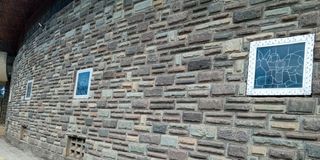The truth behind Christ the King Cathedral's architecture

Christ the King Cathedral church in Nakuru city.
There’s a reason God himself served as the architect of the Israelites' Tabernacle (Exodus 35-39).
Christ the King Cathedral Nakuru Diocese exemplifies this with its striking architecture, often mistakenly thought to resemble Noah's Ark.
The church was built in 1975 under the leadership of Bishop Ndingi Mwana a'Nzeki and designed by Mr Brenda Ellis. Its unique form is rooted in the bishop’s love for sports.
Ogolla Mjomba, explains that the cathedral’s shape is inspired by a rugby ball, while its roof symbolises the tips of a bishop’s skullcap, showing leadership within the church.

Director Radio Yetu Ogolla Mjomba during ani interview outside Christ the King cathedral on October 2, 2024.
"Christ the King is the cathedral of Nakuru Diocese," he says, “with the roof's corners pointing toward the eastern and western horizons, allowing the glass walls to reflect golden sunlight at sunrise and sunset.”
The church also features 14 terrazzo windows, representing the 14 Stations of the Cross, commonly known as 'Njia ya Msalaba.'
According to Ogolla, "The terrazzo windows and the entry floor are meant to signify that everyone within the church has a role to play, whether big or small."

Some of the terrazzo windows on Christ the King Cathedral church on October 2, 2024.
At the church’s entrance, four steps represent the fourth commandment, a sign of its significance in the cathedral of the Nakuru Diocese.
Additionally, there is only one gate on the west side, symbolising the journey of Cleopas and his companion returning to Jerusalem to spread the good news after Christ’s resurrection (Mark 16).

Entrance to Christ the King church.
This serves as a reminder that salvation is open to all and that believers are called to share the message of Christ’s resurrection.
Outside, the church has a pillar ark, a cross at the top and two white sculptures which symbolizes prayer while facing Golgotha, where Jesus Christ was crucified.
Inside the church sits the bishop’s throne (Cathedra) shaped like an African stool with a straight back to signify authority.

The cathedra inside Christ the King Cathedral church on October 2, 2024.
It cannot be moved from the church since where the cathedra is stationed, it automatically becomes a cathedral.
The church can host up to 3,000 congregants.


